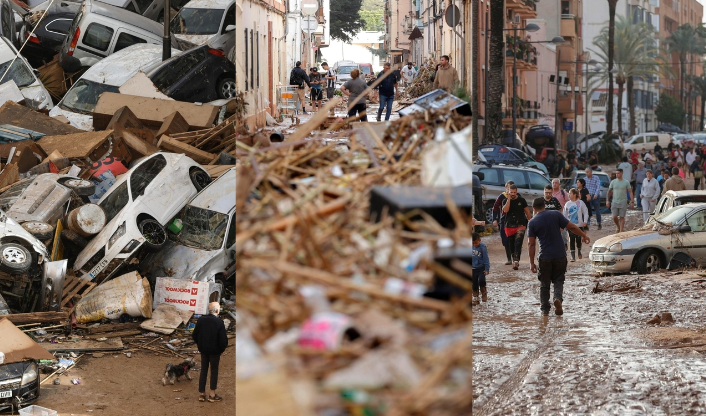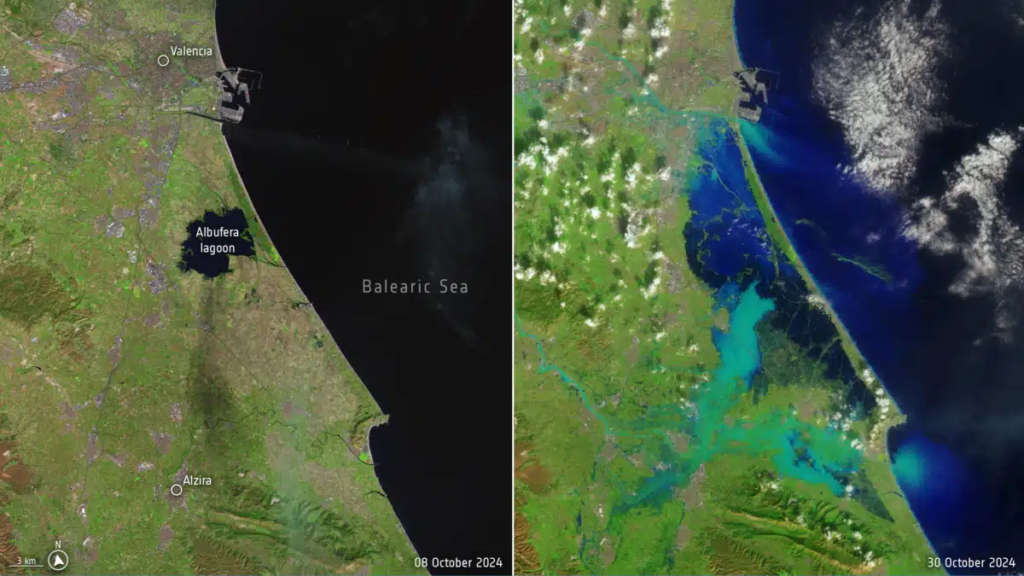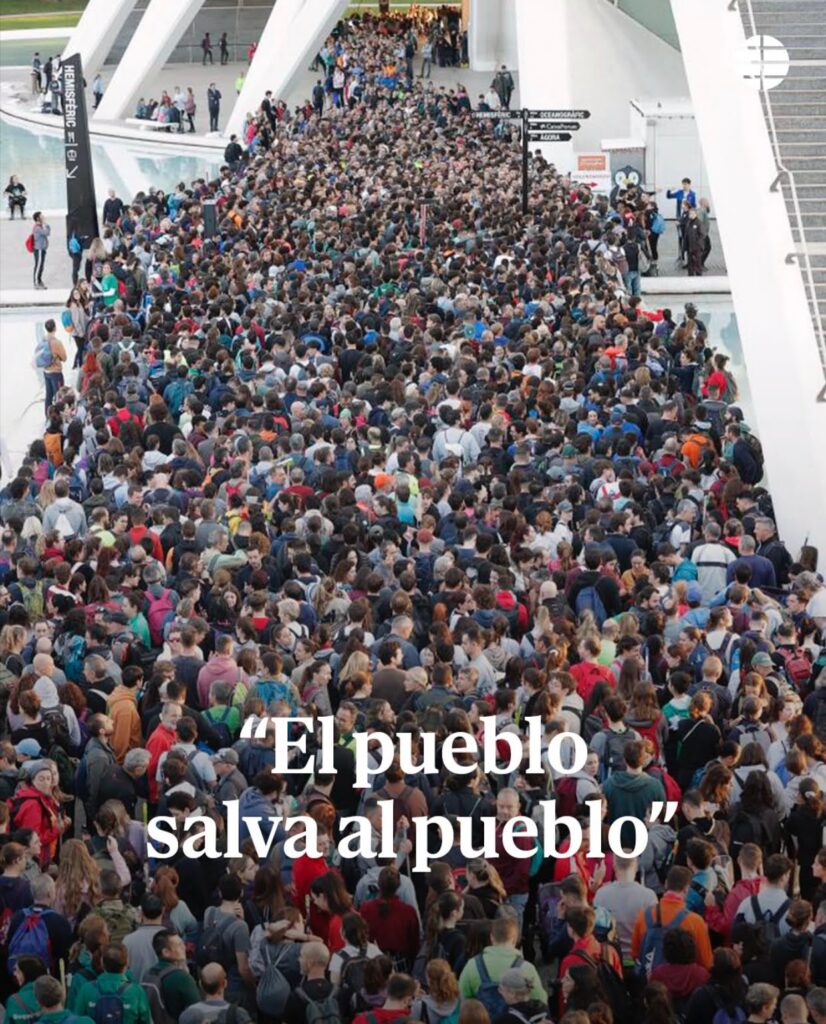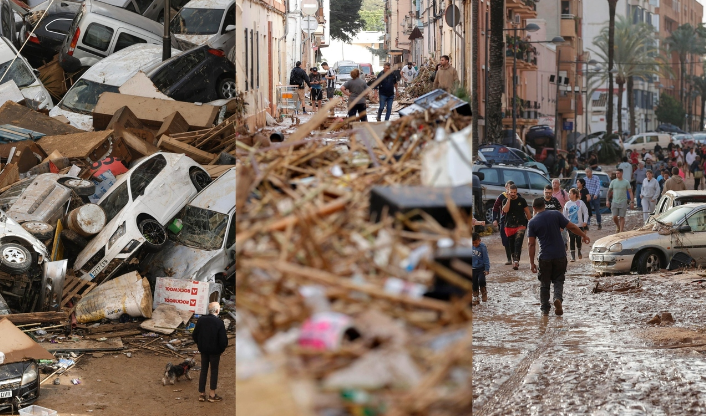
Claiming at least 158 deaths and leaving hundreds more missing or abandoned, last year’s DANA (Isolated Depression at High Levels) storm in Valencia was one of Spain’s worst natural disasters in more than a century. Unusually heavy rain caused disastrous floods throughout the area. Some regions saw up to 180 liters of rain per square meter in a short period.
A DANA is an intensified “cold drop,” formed when warm air collides with a stagnant cold air mass at around 9,000 meters (29,500 feet). This occurs when strong upper-atmosphere winds oscillate, trapping cold air in place—in this case, over southeast Spain. When this trapped cold air meets very warm air near the surface, particularly above the warm Mediterranean, a strong temperature contrasts with the winds of the Atlantic Ocean, causing warm air to rise and collect water vapor. Combined with Mediterranean humidity and post-summer warmth, this process leads to intense storms and torrential rains.
As Jorge Olcina, director of the Climatology Laboratory at the University of Alicante, told Live Science, “The winds may not be as violent as those of a hurricane, but in terms of rainfall and intensity, they can even surpass them.” Iago Pérez, a geoscientist at the University of Oxford, affirmed that DANAs are one of the most dangerous meteorological phenomena in Spain, noting that “they release enormous quantities of water in a very short time.”

With the DANA attracting a lot of attention, there was also a lot of misinformation in the media on whether or not the DANA was engineered by Moroccan authorities to destroy the region’s crops in order to achieve agricultural superiority. Nonetheless, this idea was countered by many stating that the unfounded argument was built on xenophobia and racism.
A delayed response by government officials accompanied this catastrophic weather, despite warnings from Spain’s meteorological office. The slow reaction to the deadly DANA storm in Valencia attracted major criticism from locals. By the time the government acted, Valencia and surrounding areas had already faced severe flooding, infrastructure damage, and widespread power outages.
It was not until five days after the DANA that local and national authorities finally coordinated their emergency efforts on November 5. The Military Emergency Unit (MEU) started relief and recovery operations in the most impacted districts on November 8 to help recovery and relief in the most impacted districts. However, this delay left many areas struggling without adequate support for days, intensifying local frustrations and criticism of the slow political response to the crisis.
While many banded together to meet the crisis, others opted to sow division. Following Valencia’s tragic floods, conspiracy theories proliferated online. “It’s not called DANA or Cold Drop. It’s called HAARP GEOENGINEERING. And maybe Morocco has something to do with it (…) to ruin its competitors during the orange and vegetable season.” This assertion represents the idea that the DANA storm was purposely created by the High-frequency Active Auroral Research Program (HAARP), a U.S. research program frequently mentioned in conspiracy theories. It also implies that Morocco could have utilized this technology to undermine Spain’s agricultural economy during peak production. These conspiracies contend that Morocco intended “to ruin its competitors in the middle of the orange and vegetable season, and even to help large corporations acquire cheap land for renewable energies.” However, such narratives circulated long before the Valencia floods.
Environmental expert Mostafa Benramel responded to these theories, stating, “These conspiracy theories are often fueled by individuals with different agendas or those looking to profit from online sensationalism.” He added that, “We would expect official statements from Spanish or Moroccan authorities if there were any truth to these claims. As it stands, these are unfounded rumors.” Despite their excellent monitoring and forecasting systems, “neither Spain nor Morocco has satellite capabilities to control weather patterns,” according to Benramel.
These myths can take the blame off of the real drivers of climate change, like manufacturing, polluting, and so forth. Beneath these claims lurk a deeper racism and xenophobia. These narratives also shift responsibility from the governments to imaginary outside causes. By ignoring the real problems, these conspiracy theories destabilize democracy and dehumanize people in times of crisis. In the days to come, we should all be focused on the real problems: climate change, government negligence, and adaptation to our new climate realities, and not on the misinformation which distracts from the true causes of extreme weather.
Contrary to common knowledge, geoengineering does not refer to any action that has an impact on the environment or weather patterns. While common environmental activities such as reforestation, agricultural improvements, and traditional conservation methods help to reduce carbon emissions, they do not involve the dramatic, global-scale alterations that geoengineering does.
Similarly, localized and temporary procedures, such as cloud seeding, which is intended to boost rainfall in specific locations, are frequently misclassified as geoengineering. However, these technologies lack the global size and systemic influence required to be classified as geoengineering.
Experts agree that climate change is playing a significant role in intensifying DANAs, and the devastating event in Valencia is a clear example. Dr. Jorge Olcina explains that the Mediterranean Sea, one of the fastest-warming bodies of water, acts as a “transmission belt for humidity and energy,” intensifying storms that form above it. Since the 1980s, the Mediterranean’s average temperature has risen by 1.5°C (2.7°F), nearly twice the increase in air temperature. These rising sea temperatures extend the “DANA season,” as the Mediterranean now heats up earlier and retains warmth longer — supporting more frequent and intense storms from May to November, compared to the previous peak in September and October. The annual occurrence of DANAs has risen by 15-20% over the past sixty years, underscoring climate change’s impact on the region’s weather systems.
The pattern of increasingly severe DANAs underscores the need for better communication and adaptation strategies, argues Dr. Antonio Gómez. He highlighted that “when there are fatalities, it means something has gone wrong.” He advocates for improved early-warning protocols to ensure that communities can anticipate and respond to these extreme weather events effectively.
The Spanish government’s delay in responding to the DANA storm in Valencia raises major questions about political meddling and inefficiency. Pedro Sánchez, President of the Spanish Government and head of the PSOE (Spanish Socialist Workers’ Party), and Carlos Mazón, President of the Valencia provincial government and member of the opposition Popular Party (PP), have a history of political disagreements. This divide may have contributed to the delay in action, as both leaders may have been hesitant to take decisive action due to political considerations and a desire to escape criticism. Critics believe that the political impasse resulted in avoidable deaths, with a delayed response aggravating the crisis and slowing rescue efforts. The five-day delay in the government’s response to the DANA storm caused great resentment throughout Spain, mainly in Valencia but also in Madrid. As official inactivity persisted, popular dissatisfaction boiled over, sparking riots and marches demanding accountability. At the same time, there was an outpouring of solidarity, with tens of thousands of volunteers organizing to help in the afflicted areas. The slogan “El pueblo salva al pueblo” or “The people save the people,” quickly became a rallying cry that encapsulated the ethos of grassroots cooperation and mutual aid. In the face of government apathy, residents came together across party lines to help those affected by the disaster.

This spontaneous mobilization of volunteers represented a strong rejection of political divisions, with the focus shifting completely to humanitarian activities. Volunteers from all walks of life, regardless of political affiliation, worked together, expressing the spirit of unity. The message was clear: in times of disaster, it is not political groupings that matter, but rather the common human impulse to aid one another.
Five days after the disaster, as the authorities finally arrived in the region — alongside the King and Queen of Spain in Paiporta, the epicenter of the destruction—citizens greeted them not with gratitude, but with anger and disillusionment. The public’s response to the visit was one of shock and resentment, as the scale of the devastation was laid bare. The horror of the storm’s aftermath was a stark reminder of the cost of political delay, with the people now demanding more than just symbolic gestures from their leaders. The moment served as a harsh critique of the political system, showing that in the eyes of many, the true heroes were those who acted selflessly in the face of government inertia.
Other posts that may interest you:
Discover more from The Sundial Press
Subscribe to get the latest posts sent to your email.





